Posts Tagged ‘Rare coin’
The story of the 1885 Trade Dollar worth millions!
A few years ago, we were asked to identify an unusual coin, which on first glance appeared to be a US Trade Dollar from 1885. However, once we started researching this coin, it became obvious that it must have been a fake.
Here’s why a genuine 1885 Trade Dollar would be impossible to find…
One of the rarest coins on the planet
In 2019, the finest known 1885 Trade Dollar was sold for an eye watering $3.9 million at Heritage Auctions! Whilst this US coin may not be familiar to UK Change Checkers, it is incredibly rare – perhaps one of the rarest coins on the planet.
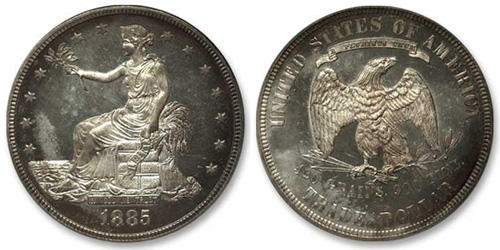
The US Trade Dollar was designed by William Barber and features Lady Liberty seated on a pedestal of merchandise, facing across the sea and holding an olive branch. On the reverse, an eagle holds branches laden with berries within its talons – an iconic American image. This design remained unchanged besides minor modifications up until the last coin of the series was struck.
Creation of the Trade Dollar
Made from .900 Silver, these coins were struck primarily for trade with Asia and were competing against the other large silver trade coins which had already become popular in the East.

The 1873 Coinage Act made these coins legal tender for payments up to five dollars and many made their way into American commercial channels, despite the majority being sent to Asia.
As their distribution across America became more widespread and the price of silver fell, the coins were demonetised, although many 1873 – 1883 Trade Dollars can still be found on the secondary market today and are often sought-after by US collectors.
The greatest numismatic mystery…
In 1878, production of circulation strikes officially stopped. The Philadelphia Mint continued to strike Trade Dollars after this, however the coins were only issued in proof quality for numismatic purposes.
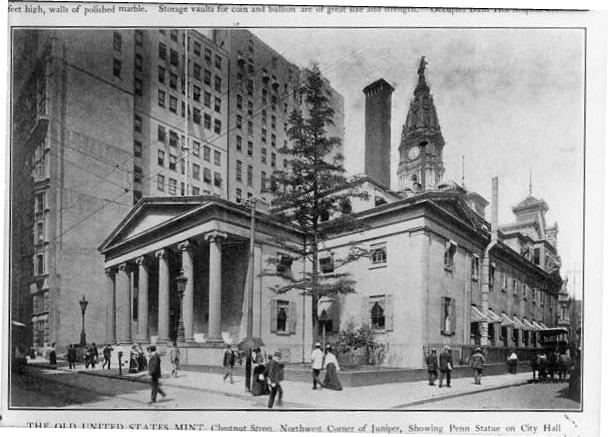
Credit: Moses King, Public domain, via Wikimedia Commons
It was initially believed that the final year of production was 1883, however over two decades later, 1884 and 1885 dated Trade Dollars created a sensation when they appeared on the secondary market.
Incredibly, just 10 1884 proof quality Trade Dollars were struck and more astonishing still is that only 5 of these coins were struck in 1885!
Imagine how exciting it would have been to first find out about these secret coins, and how desperate American collectors must have been to get their hands on one!
Lack of documentation means the origins behind their creation still remains one of the greatest numismatic mysteries… It’s actually thought that employees from the Philadelphia Mint secretively struck the coins after production was halted.
Sold for $3.9 million!
All 5 coins from 1885 are now accounted for and are owned in private collections, meaning the public rarely get the chance to see these coins exhibited.
A few of the 1885 Trade Dollars have sold at private auction, reaching phenomenal prices. One of the finest specimens from the Eliasberg Collection appeared at Heritage Auctions in 2019 and sold for $3.9 million!
President of Heritage Auctions, Greg Rohan said, “Owning the finest-known [1885 Trade Dollar] specimen is to own an enduring symbol of numismatic and American history.”

So, whilst the 1885 Trade Dollar would be an exceptional coin for any collector to come across, as all 5 1885 Trade Dollars are accounted for, the only explanation for the coin we were asked to look at is that unfortunately it must have been a fake.
It really would be amazing to be able to own a coin as rare as this though! What would you do if you came across such a unique coin in your change?
There are so many fascinating stories about different coins from all around the world and if you have a story about a rare or unusual coin, we’d love to hear it!
If you’re interested in coin collecting, our Change Checker web app is completely free to use!

Why is the Tosha Cat £2 one of the Isle of Man’s most sought-after coins?
In September 2011, the fourth Commonwealth Youth Games were hosted on the Isle of Man and to commemorate this sporting event, Pobjoy Mint issued a new £2 coin on behalf of the Isle of Man Treasury.
This £2 coin featured the official Commonwealth Youth Games Mascot, Tosha the Cat and the official logo of the games.
But what makes this £2 coin so special?
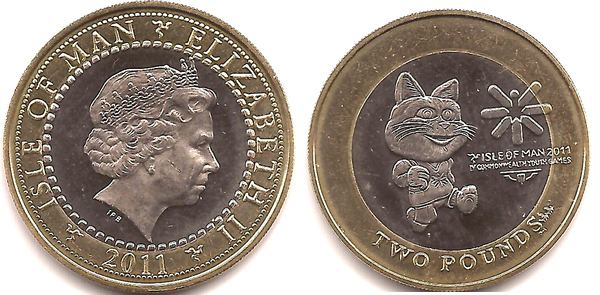
The name ‘Tosha’, meaning ‘first’ in Manx Gaelic is fitting considering this was the first time the games were held on the island. However, even though this significant sporting event and the fun design representing it would make this coin a great find for collectors, the popularity of the Tosha Cat £2 on the secondary market remains a force to be reckoned with…
The rise of the Tosha Cat £2
So how did this £2 coin come to be so popular?
Whilst rarity is normally a large factor in how collectable a coin is, mintage figures for British Isles coins are notoriously hard to track down and this coin is no exception. No one actually knows the true mintage figure, so it can’t be said how rare the coin is, although we do know that British Isles coins typically have lower mintages than UK coins due to the smaller population.
One thing we do know for certain is that the Isle of Man Tosha Cat £2 is definitely sought-after amongst collectors.
Although the Tosha Cat £2 was issued in 2011, it wasn’t until it was posted on Facebook coin groups in 2018 that the price started skyrocketing on the secondary market. In fact, in 2018 this coin became ‘Coin of the Year’ on Facebook coin groups, and this is where it really found its success.
Following the Facebook hype surrounding the Tosha £2, eBay bidding wars began. At a time when the Kew Gardens was selling for around £80 on eBay, this coin was regularly selling for double that!
Listed for thousands of pounds on eBay!
In fact, listings on eBay continue to regularly exceed £100 and even go up to thousands of pounds for this Isle of Man coin!

Although the coin may not actually sell for such eye watering amounts, a quick check of the recent ‘sold’ listings shows that some collectors are willing to pay more than 50 times face value to own this coin!
More commonly the coin sells for around £12, which is still an impressive 6 times its face value.

Beware of Fakes!
As is the story with the Kew Gardens 50p, the popularity of this coin has unfortunately led to fakes being produced and sold on the secondary market, taking advantage of unsuspecting collectors who would be willing to pay well over face value to own the coin.
If you’re looking to secure the Isle of Man Tosha Cat £2 for your collection, it’s certainly worth doing your research, buying/swapping from a reputable seller (look for eBay feedback or successful swaps on Facebook groups) and checking the images of the coin to make sure it looks legitimate.

The image above gives you an idea of what a fake Tosha Cat £2 coin may look like.
Fake coins will be overly shiny, the strike will be much less defined and the coin may well weigh less than the standard 12g £2 coin.
Popular Isle of Man Coins
The Isle of Man has released some fantastic coins over the years, including the much-loved Christmas 50ps, TT race coins and most recently, this year’s hugely popular release of the Peter Pan 50ps.
As the Isle of Man has some wonderful coin designs and really exciting collecting opportunities, you can see why more and more UK collectors are turning their attention to British Isles coins. But do you have any in your collection?
Own both 2019 Isle of Man TT £2 coins!

If you’re interested in collecting Isle of Man coins, you’ll love the 2019 Isle of Man TT £2 coin duo, which is now available in Brilliant Uncirculated condition.
How much is my coin worth? June 2019 eBay Tracker update!
We’re excited to present your latest eBay Tracker and Valuation Index for the Top 10 UK coins and banknotes!
The secondary market can be a bit of a minefield, but if you’ve found a rare coin or banknote and want to work out how much it might be worth, we’ve done the hard work for you…
eBay Tracker
Find out which coins and notes have been the key movers and shakers in the updated eBay Tracker below.
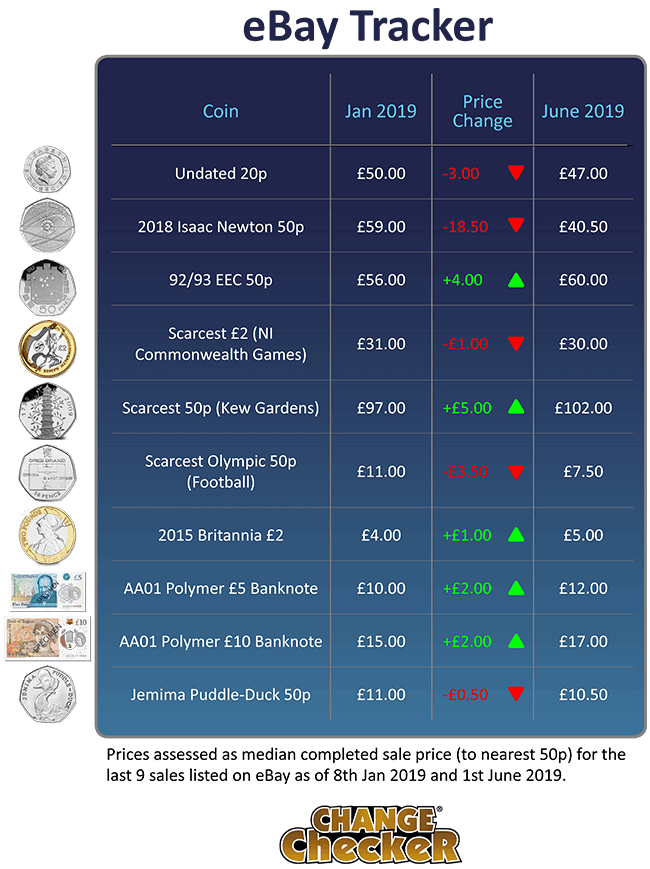
The most notable increase from the last update goes (unsurprisingly) to the Kew Gardens 50p, which has increased in price on the secondary market by £5 and is currently selling for around £102 on eBay – more than 200 times its face value!
Whilst many collectors were concerned that the 2019 Brilliant Uncirculated re-issue of this 2009 coin would make it less collectable, it seems that in fact the opposite has happened and the reinvigorated hype surrounding the UK’s rarest 50p in circulation has led to an increase in demand for the coin, meaning collectors are willing to pay more to get their hands on one.
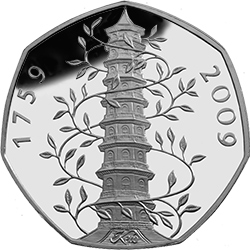
Other increases to mention are the AA01 serial number polymer banknotes, as both the £5 and £10 notes have increased by £2 since the last update, which is a 20% increase on January’s figures for the £5 and 11% for the £10 note.
Overall there has been a decrease in value for the Top 10 coins and banknotes and this is mostly due to the 2018 Sir Isaac Newton 50p, which has dropped by 32% on January’s figures and is currently selling for £40.50.
This coin was issued as a ‘Strike Your Own Coin’ from The Royal Mint Experience in 2018 and due to the short time frame it was available for, the number of coins struck could be really low, meaning it may well be very rare.
However the mintage figures for this coin haven’t been revealed by The Royal Mint yet, so we don’t know exactly how many were struck. When the official figures are released we could well see this coin increase in value on the secondary market.
Valuation Index
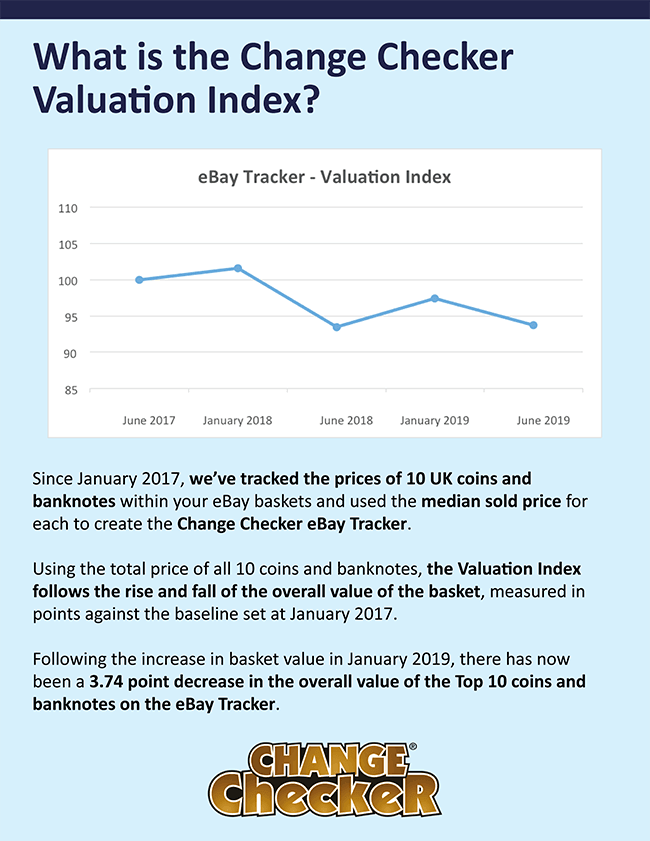
My coin isn’t on the eBay Tracker
The eBay Tracker follows the movements of the Top 10 UK coins and banknotes, however if your coin doesn’t appear on the tracker you can use our 6 point guide to help determine realistic a value for your coin.
So now that you’re up to date with our latest eBay Tracker, will you be selling any of the coins in your collection or will you continue to save them? Let us know in the comments below.
How does the eBay Tracker work?
The Change Checker eBay Tracker takes the last 9 sold prices achieved on eBay and gives the median price achieved (rounded to the nearest 50p). By taking the median, rather than an average, we avoid skewing created by one or two excessive prices achieved.
Please note that the Change Checker eBay Tracker is only ever designed to be a guide as to prices achieved on eBay. Prices may vary depending on collector demand and the quality of the coin being sold. It does not provide any guarantee as to future values of coins.
If you’re interested in coin collecting, our Change Checker web app is completely free to use and allows users to:
– Find and identify the coins in their pocket
– Collect and track the coins they have
– Swap their spare coins with other Change Checkers
Sign up today at: www.changechecker.org/app

